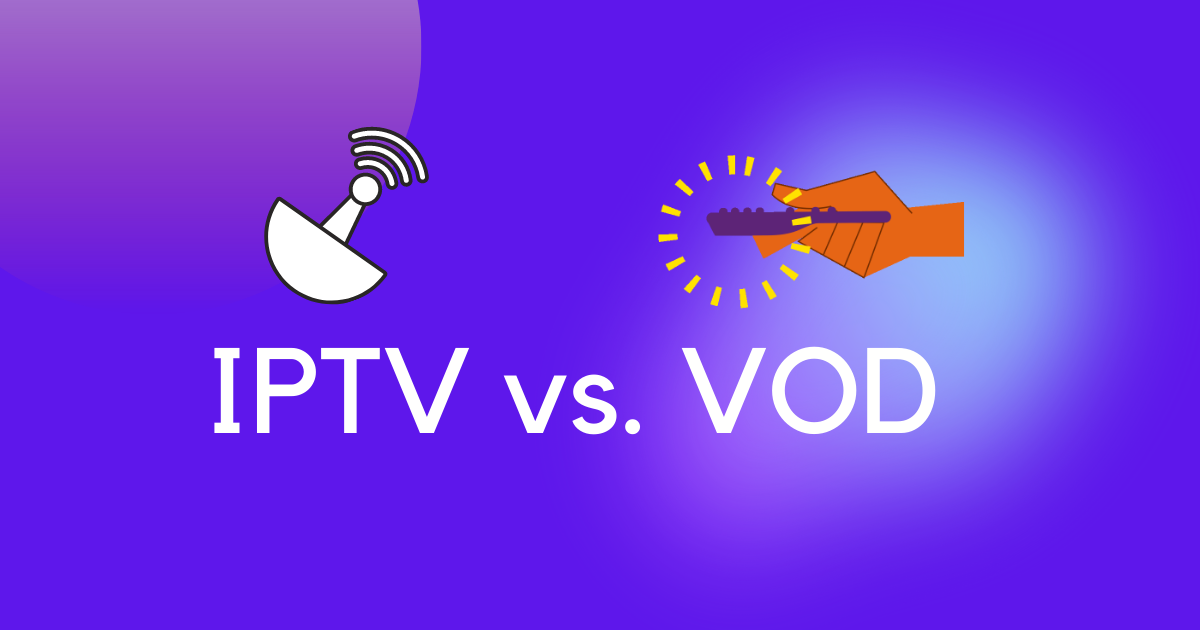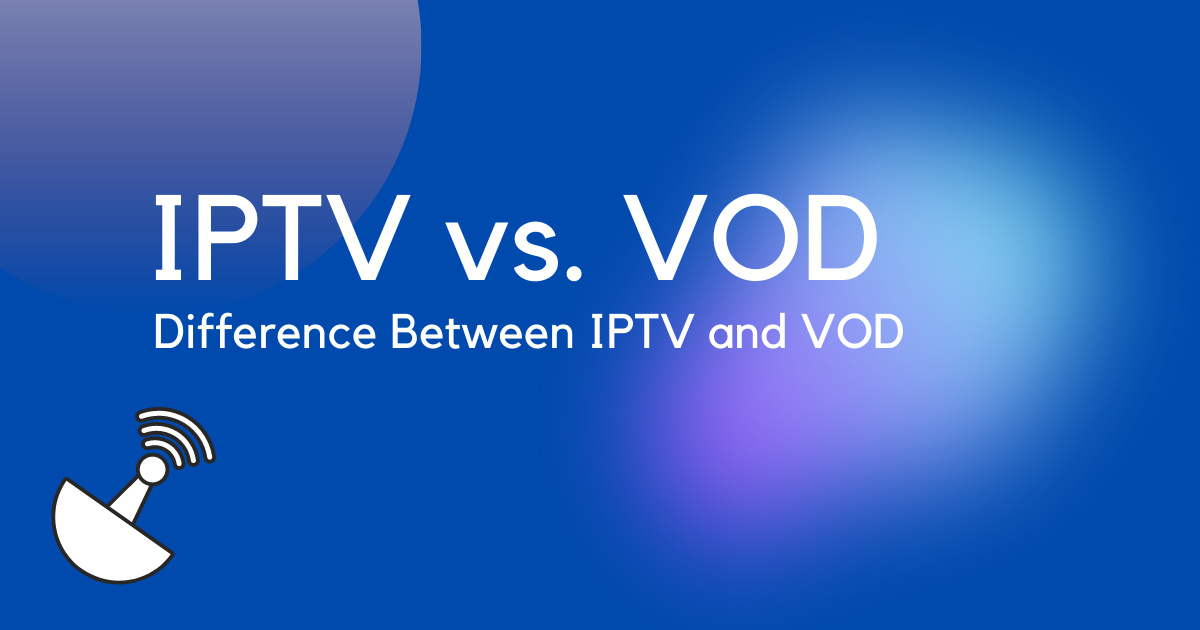You’ve come to my site because you’re looking for the best answer for what is the difference between the two services IPTV and VOD. Then you’ve arrived at the ideal location. This article will aid you in educating you about IPTV vs VOD.
It’s the acronym for the Internet Protocol box if you’re not familiar with the word. IPTV is a relatively new broadcasting technology. It allows users to record and stream content over the Internet. It’s a less expensive alternative to satellite systems and conventional lace connections.
On the other hand, Video on Demand (VOD) is a short term for a video that is streamed over the internet. VOD is a service that delivers stored information via the internet. Such as movies, television music, and others.
However, this is just the definition of IPTV and VOD. These streaming platforms have more requirements than people think. Thus, I would recommend you to go through the whole article.
What exactly is IPTV?

IPTV is a process that delivers the Transmission Control Protocol/Internet Protocol suite. It does not use broadcast, cable, or satellite signals to provide television programming. And also any other multimedia information.
An IPTV service, which is often supplied by a service provider, uses IP networks to broadcast. Like live TV shows or on-demand video material.
How does Internet Protocol Television or IPTV Service work?
If you’re wondering what IPTV is, it’s the abbreviation for Internet Protocol Television. which is also known as IPTV.
Through the ISP Network, IPTV services deliver traditional television services. Such as live channels to your house.
It may be understood by thinking that traditional tv services or cable tv are with an ISP. And that you can get the feed of this television via your internet connection whenever you want.
Actually, I’ve used the following premise to help you grasp the basic concept of IPTV. So rest assured that the entire process is different in reality. The driver gets direct or lives material from content providers. Through vivid styles in order to deliver IPTV services. It’s possible that satellite downlinking, teleport, or over-the-air communications will be used.
IPTV services is frequently supplied through a managed or specialized network. Such as DSL. A private network, as opposed to the public internet, allows network operators more control over video traffic. As a result, the ability to guarantee the quality of service, capacity, and dependability.
In conventional television distribution, all content is broadcast in a multicast fashion. Which means at the same time. The available program signals go downstream. And, viewers pick programs by adjusting the television channel.
A unicast IPTV service, but delivers only one program at a time. Only the program that the end user picks transfers to the user’s device. While the content stays on the internet service provider’s network.
When a viewer switches the channel, a fresh stream goes immediately to the viewer. IPTV requires a set-top box or additional customer premises equipment. Such as a Wi-Fi router or a fiber optic or broadband internet connection.
For IPv4-based live television broadcasts, IP multicasting using Internet Group Management Protocol. While for on-demand shows, Real-Time Streaming Protocol is used. On IPv6 networks, Multicast Listener Discovery is employed. Real-Time Messaging Protocol and Hypertext Transfer Protocol are two more prevalent protocols.
Pros and Cons of IPTV Services:
Pros
· Quality: it works on a privately controlled distribution network. The video quality is excellent and there is almost no buffering time almost better than cable or satellite tv.
· Programming: New episodes are released on a regular basis or are accessible on demand.
· Installation: There’s no need to fix anything. All you’ll need is a set-top box and consistent internet connectivity.
Cons
· Price: Cable TV is still less expensive than IPTV service.
· Quality: IPTV services, especially during busy hours, might degrade quality
Just what is VOD (Video on Demand)?

VOD delivers stored material such as photos, series, and other media through the Internet. It may be understandably assuming that your requested CD or DVD players are with ISP. And that you are receiving the feed of this CD or DVD on your internet connection. whenever you want it since the entire catalog of films is accessible to watch at any time.
To begin, I’ve used the following premise, like IPTV, to help you comprehend the basic concept of VOD.
As a result, you might claim that the entire procedure is unique. The user obtains video material from content providers to provide VOD services. Such as pictures, series, music, and so on. Warner Bros. might be the source.
VOD, or video-on-demand, is any content distribution platform. It gives viewers the ability to choose when, where, and how they view media.
VOD delivers through the internet rather than through cable or satellite. As is the case with traditional broadcast television. You can watch if you have adequate bandwidth! Users may use any internet-enabled device to search. And, view pre-recorded streaming material.
Users have complete control over when and how they watch material. Unlike “linear” television, which transmits in real-time, VOD does not have a predetermined schedule. When opposed to regular TV scheduling, users have more flexibility. In terms of what they watch.
Viewers manage how they watch material by playing, pausing, rewinding, and fast forwarding. They won’t miss any vital information this way. When all of this is considered, VOD allows people to watch material in a simple and accessible manner.
Pros
· Convenience: VOD gives major vendors such as Amazon Prime and Netflix. They offer a large inventory of videos to view on-demand, as many times as you like.
· Connectivity: All you need is an internet-connected computer or television.
· Cost: It costs a lot less than satellite or cable and has a lot more programming.
· Variety: You may watch sports shows, news, TV series, and other movies. In the past, that is available on any device with an internet connection, anywhere, at any time.
· Devices: You may access any file from any device, at any time, and as many times as you desire.
Cons
· Use of Bandwidth: Streaming will necessitate additional bandwidth, especially for higher-quality videos.
· It’s possible that the material you want isn’t available in your area. It’s possible that some material isn’t available in your nation or region.
· It’s possible that the material you want isn’t available on your on-demand platform. The service provider decides what’s available. And may exclude some films based on what the majority of users watch.
IPTV VS VOD

Because IPTV or Internet Protocol Television is built on a two-way protocol, it allows the user to interact more with the medium and the content. The supplier will be able to better suit the needs of the user. They have control over the programs and their schedule.
IPTV will be the motor that propels the new era of interactive content forward. Operators’ success or failure will be determined by their ability to stay ahead of the curve. With the new technology, content formats, and revenue models that IPTV introduces.
IPTV supports the ‘trick play’ capabilities of stop, rewind, and fast forward that we see on DVRs. This does not allow us to modify the content, but it does allow us to regulate how and when we watch it.
IPTV takes it a step further by allowing you to interact with the program content. Such as, buying a product promoted or voting on a reality TV show using your remote control. IPTV, in its most advanced version, will immerse you in the show. Giving you the material changing based on user interaction.
Another benefit of IPTV that is more straightforward is its dependability. IPTV feeds, unlike terrestrial TV, are not affected by the weather. They are provided via the internet. Naturally, if your internet connection is inconsistent, you may experience issues.
IPTV also comes with a slew of other capabilities. Such as the ability to view content interactively or record it on a schedule. IPTV also allows access to a significantly broader range of channels. And programs because it does not rely on a license to transmit over radio frequencies.
· User Experience – IPTV is live content. You can’t pause, rewind, or catch up on it, but you can utilize PVR functionality with VOD.
· Type of Content: IPTV is live material (for example, a live football match). Whereas VOD is recorded content (any movie says Titanic).
· Mode of Delivery: IPTV uses multicasting (one to many), whereas VOD or Video on Demand vod uses unicasting (one to one)
Requirement
For content delivery, IPTV requires apps, network stability, and infrastructure. A set-top box and an IPTV Service Provider are also required for IPTV.
VOD does not necessitate the use of several system operators to deliver the material. It just connects to a public network that is unmanaged.
Casting technique
· IPTV transmits data to many users (for example multicasting).
· A single user receives data from VOD (for example unicasting).
Content types include
IPTV or Internet Protocol Television offers live programming in the same way that traditional television does. As well as content from the internet via the internet protocol.
VOD uses the internet protocol to enable access to offline or stored material such as a movie.

